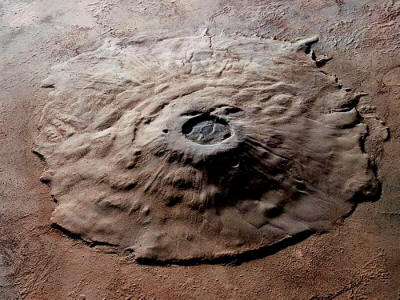|
by Marc Kaufman
from
NationalGeographicNews Website
as seen via
self-portraits of its undercarriage.
NASA's
Mars rover Curiosity has made its
first major science discovery, and it's one for the ages.
Planetary scientists have hypothesized that the cut canyons and river-like beds photographed by Mars satellites had been created by running water, but only now do they have on-the-ground confirmation - and the promise of learning much more about the nature and duration of the water flows.
by Richard A. Lovett
from
NationalGeographicNews Website
with H2O, meteorite study
hints.
Mars could have entire oceans' worth of water locked in rocks deep underground, scientists say. The finding suggests that ancient volcanic eruptions may have been major sources of water on early Mars - and could have created habitable environments.
According to a new study, Martian meteorites contain a surprising amount of hydrated minerals, which have water incorporated in their crystalline structures.
In fact, the study authors estimate that the Martian mantle currently contains between 70 and 300 parts per million of water - enough to cover the planet in liquid 660 to 3,300 feet (200 to 1,000 meters) deep.
And if water exists today in the Martian mantle, that means the red planet likely had a lot of water in its interior all the way back to the moment the planet formed.
And if that's the case for Mars, it's probably the case for the other rocky planets - Mercury, Venus, and Earth - as well as for some large asteroids.
Water Boiled Out of Mars Lava
McCubbin's team found water while analyzing meteorites that had been blasted off the Martian surface by asteroid impacts and sent careening to Earth.
The meteorites are basaltic, which means the rocks must have formed from deep magmas brought to the surface during volcanic eruptions. By carefully examining a mineral called apatite, McCubbin's team found hydroxyl ions - a form of water that contains an oxygen atom bound to a hydrogen atom.
The presence of hydroxyl means that standard water - oxygen bound to two hydrogens - was also present in Martian magma. But because the hydroxyl is more tightly bound to rock than ordinary water, the ions remained behind when the rest of the water boiled out of the cooling lava.
From the amount of hydroxyl in the meteorites, it's possible to reconstruct how much water is in Mars's interior, McCubbin added.
Furthermore, he said, the Mars meteorites examined in the new study came from extremely young basalts, only 150 to 350 million years old.
That means all large Martian eruptions throughout the planet's history probably carried substantial water to the surface - including eruptions that happened during the Noachian, the period when ancient Mars was warm enough to have possibly hosted liquid water on the surface.
It's also possible more recent eruptions might have created zones that were temporarily favorable to life as we know it.
|


